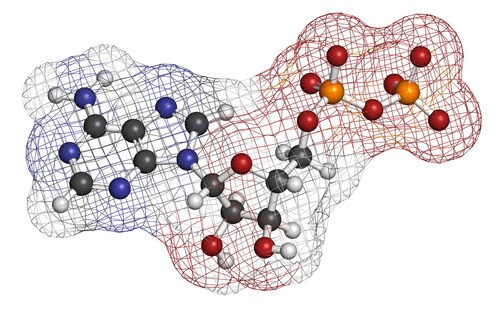 ADP-ribosylation is catalyzed by ADP-ribosyltransferases (ARTs) and is an important component in cell signaling, DNA repair, gene regulation and apoptosis.1 While researchers have been able to identify some ADP-ribose covalent acceptor sites, this work is not without its challenges.
ADP-ribosylation is catalyzed by ADP-ribosyltransferases (ARTs) and is an important component in cell signaling, DNA repair, gene regulation and apoptosis.1 While researchers have been able to identify some ADP-ribose covalent acceptor sites, this work is not without its challenges.
As a post-translational modification, ADP is easily lost during extraction or sample preparation. Another problem arises in identifying remaining ADP-riboslyated proteins, since the ADP-ribose modification is highly transient. Hydrolytic enzymes can degrade poly-ADP-ribose (PAR) to mono-ADP-ribose (MAR).
Rosenthal et al. explain that another stumbling block lies with a lack of suitable methods to identify and quantify the actual amino acid acceptor sites on ADP-ribosylated proteins. To meet the need for better ADP-ribosylation detection, Rosenthal et al. optimized a method to identify ADP-ribosylation sites using a hybrid ion trap-Orbitrap mass spectrometer.2
The researchers prepared ADP-ribosylated samples using the peptide biotin-KAARKSAPATGGVKKPHRYR (H3) and a mixture containing the four core histones as well as the H1 linker histone as full-length proteins.
For their analysis, the team chose an LTQ Orbitrap Velos ETD mass spectrometer (Thermo Scientific) coupled to a high-performance liquid chromatography (HPLC) system. They also used Proteome Discoverer software revision 1.4 (Thermo Scientific) to analyze data.
The team combined higher-energy collisional dissociation (HCD) with electron-transfer dissociation (ETD). They remarked that this strategy produced more comprehensive coverage of ADP-ribosylation sites compared with HCD alone. The authors noted that in principle, combining ETD and HCD results in increased cycle times, a lower number of identifications and assigned spectra, and is inefficient for complex samples. Instead, they used HCD followed by ETD on the same precursors only when one or more marker ions was present in the HCD spectra, or a product-dependent approach.
After further analysis, the team was able to improve results even more using an HCD spectra ion trap product-dependent approach, or two-stage ion trap HCD-ETD. This helped identify ADP-ribosylation sites with high reliability and confidence for in vitro modified proteins.
With these approaches, the researchers identified 167 ADP-ribosylated peptides and several ADP-ribose acceptor sites (Glu, Asp, Lys and Arg) on various different proteins with high confidence.
Rosenthal et al. are encouraged by these findings. They suggest this work will help expand understanding with the goal of reliably identifying ADP-ribose acceptor sites in complex samples.
Reference
1. Chapman, J. D., et al. (2013) “Mapping PARP-1 auto-ADP-ribosylation sites by liquid chromatography-tandem mass spectrometry,” Journal of Proteome Research, 12(4) (pp. 1868–80).
2. Rosenthal, F., et al. (2015) “Optimization of LTQ-Orbitrap mass spectrometer parameters for the identification of ADP-ribosylation sites,” Journal of Proteome Research, 4(9) (pp 4072–4079), doi: 10.1021/acs.jproteome.5b00432.
Leave a Reply